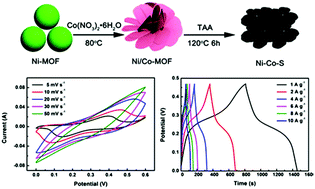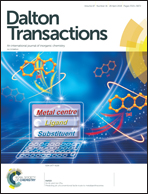Formation of bimetallic metal–organic framework nanosheets and their derived porous nickel–cobalt sulfides for supercapacitors†
Abstract
Metal–organic frameworks (MOFs) show great advantages as new kinds of active materials for energy storage. In this study, bimetallic metal–organic frameworks (Ni/Co-MOFs) with nanosheet-assembled flower-like structures were synthesized by etching Ni-MOF microspheres in a cobalt nitrate solution. It can be clearly observed that the amount of Co(NO3)2 and etching time play crucial roles in the formation of Ni/Co-MOF nanosheets. The Ni/Co-MOFs were used as electrode materials for supercapacitors and the optimized Ni/Co-MOF-5 exhibited the highest capacitances of 1220.2 F g−1 and 986.7 F g−1 at current densities of 1 A g−1 and 10 A g−1, respectively. Ni/Co-MOF-5 was further sulfurized, and the derived Ni–Co–S electrode showed a higher specific capacitance of 1377.5 F g−1 at a current density of 1 A g−1 and a retention of 89.4% when the current density was increased to 10 A g−1, indicating superior rate capability. Furthermore, Ni/Co-MOF-5 and Ni–Co–S showed excellent cycling stability, i.e. about 87.8% and 93.7% of initial capacitance can be still maintained after 3000 cycles of charge–discharge. More interestingly, the Ni/Co-MOF-5//AC ASC shows an energy density of 30.9 W h kg−1 at a power density of 1132.8 W kg−1, and the Ni–Co–S//AC ASC displays a high energy density of 36.9 W h kg−1 at a power density of 1066.42 W kg−1. These results demonstrate that the as-synthesized bimetallic Ni/Co-MOF nanosheets and their derived nickel–cobalt sulfides have promising applications in electrochemical supercapacitors.



 Please wait while we load your content...
Please wait while we load your content...